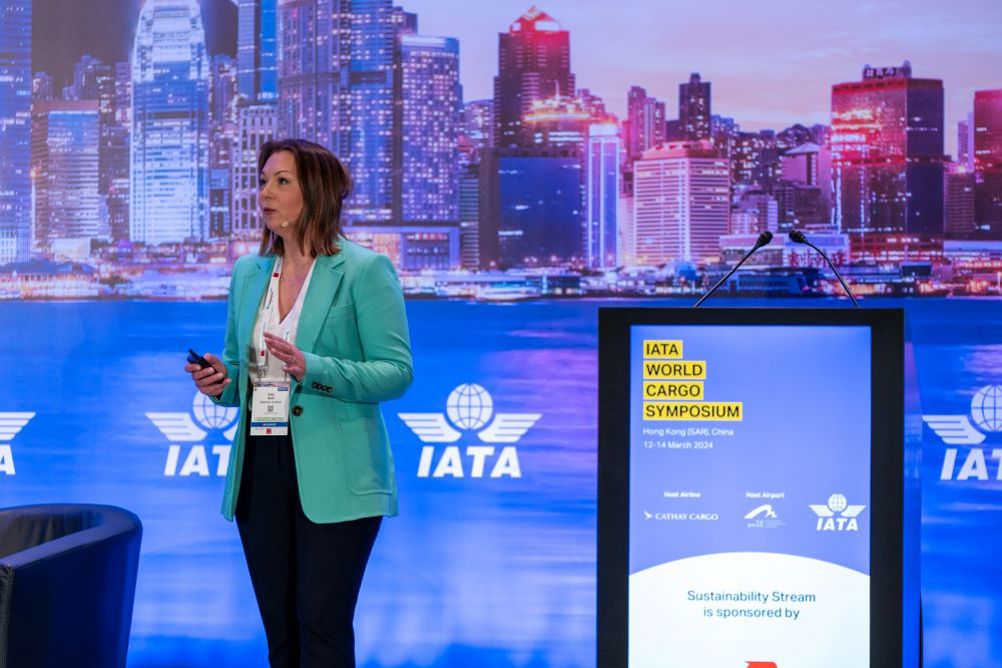
This year, around 60 million tonnes of air cargo will be handled, which is going to consume a lot of plastic, Katy Reid, Head of Sustainability and Corporate Responsibility at Menzies Aviation told audience members at the Sustainability Stream, sponsored by ACL Airshop and moderated by Vice Chairman Steve Townes.
In its cargo business, Menzies operates in 75 locations and handles around two million tonnes of cargo a year, so reducing plastic consumption and increasing recycling is very important.
The world has a chronic waste problem, Reid told the audience, who quoted the alarming statistic that 500 million tonnes of CO2 is created annually by plastic and then there are concerns about disposal with plastic going to landfill or being shipped to other countries.
All companies in the air cargo industry have an obligation to do their bit to reduce consumption and recycle plastic properly, Reid said.
The first step to address plastic consumption is to establish a baseline.
As a global company, Menzies sees variations of what plastic is available and how it is processed.
Another challenge is processing the variety inbound plastics from imports.
There are different factors when picking alternatives and not just the durability and quality of the materials.
Companies need to look at customer requirements and supplier due diligence.
“Supplier due diligence is something we are refining as we have a lot of cargo locations in different countries so we do not have a one-size-fits-all approach,” said Reid.
Sheets have traditionally been LDPE, which consume a worrying amount of natural resources and energy for production, combined with other chemical processes which have a large environmental impact.
At the end of its life, it takes a long time to break down in landfill, releases a lot of gas, leaches chemicals and leaves microplastics.
Recycled LDPE comes in various forms from 10% recycled content with Reid praising Cathay Cargo for looking at 50% for plastic sheets.
Biodegradable plastics are an alternative to LDPE, which gets mixed responses depending on the production if it is plant-based or not.
Reid said: “One of the products that we are using at Menzies is a biodegradable product, which we have rolled out across the US and Canada, and Latin America will follow very soon. That product has an additive, which triggers, if that product goes to landfill, it will degrade as if it were degrading biologically. It will degrade in roughly 8-10 years in landfill and leave no trace of microplastics.”
For Menzies’ All In Sustainability programme, a new environmental policy has been implemented to set standards across operations, selecting suppliers and for sustainable procurement.
Minimum standards have been set for air cargo operations, which is being done on regional basis.
Products will be selected that make sense in the specific locations with Reid pointing out that biodegradable products are not available globally unless they are shipped, which would create unacceptable amounts of emissions so would not make environmental sense.
Sustainability is an area of opportunity said Reid, saying just because Menzies is using products now does not mean they will be using the same products in five years time.
From its own waste, Menzies is estimated to have emitted over 7,000 tonnes of CO2e annually in 2022, and the figure was likely to be higher last year due to expanding its network.
Reid said: “In the four locations where we have implemented the biodegradable wrap product, between August and December, if that had gone to landfill, and hopefully it wouldn’t all, but if it did, we would have saved the equivalent of over four million plastic bottles from remaining in landfill for 500 years by making sure the product will degrade in a fraction of that time.”
Ending her presentation, Reid said: “We can all make a difference, we are all part of the problem. We can take action now and we have got to take action now. There is a lot of talk about different dates in the future but we have to start somewhere and while we do not have a perfect single solution for removing single-use plastic at this point in time, we can make a difference and have an impact on what we are consuming and producing.”

Sustainable growth
Mark Watts, Chief Operating Officer of the Cathay Cargo Terminal was next on stage, who looks after Hong Kong International Airport’s newest multi-purpose cargo terminal which handles several airlines including those in the Cathay Group.
The terminal has 2.7 million tonnes of annual cargo capacity and ample space for future expansion so future-proofing the facility and growing sustainably is very important, said Watts.
Cathay Cargo Terminal’s vision is to be a leader in the cargo terminal sector and part of that vision is to be a leader in sustainability.
Watts said: “It is important to benchmark and understand where are we today and where are we going in the future. So we benchmarked ourselves against our own internal goals up to net zero in 2050, it is only 26 years away and we have an awful lot of work to do as a community but the good thing is we have made a start.”
It was important for Cathay Cargo Terminal to benchmark itself against the external market as well, continued Watts.
Cathay Cargo Terminal compared itself to the other cargo terminals in Hong Kong and internationally and was pleased to report it was at least on par with the market or ahead of its competitors in many cases.
Waste management was the area of concern because many recycling centres in Hong Kong reduced or suspended services during the pandemic.
Cathay Cargo Terminal looked at certification and underwent the IATA Environmental Assessment (IEnvA) certification, receiving the certificate the previous day during the IATA Press Briefing.
Watts praised IEnvA for making sure a company’s environmental management systems are robust, saying it makes them document everything and think about their plans and that responsible people are held accountable for delivering the plans.
Wooden pallets are the biggest area of waste in the cargo terminal, said Watts, who estimates Cathay Cargo Terminal processes around 2,500 tonnes a year, around 120,000 pallets before recycling.
With wooden pallets, it is key to segregate waste and Cathay Cargo Terminal is testing AI cameras to detect waste that should not be there.
Results have been mixed so if anyone has a better solution or would like to develop one, Watts would like to hear from you.
Plastic is the next biggest area at around 560 tonnes, which is mostly cover sheets.
Most customers at the Cathay Cargo Terminal use e-air waybills, import collections have gone paperless, e-SRF has been introduced and e-payments have been launched in partnership with PayCargo, meaning much of the paper documentation has been removed from the terminal.
There are other items that need recycling such as food waste as Cathay Cargo Terminal operates 24/7 with staff, contractors and other people on site, and metal waste.
Some waste is not recyclable and that also needs to be processed.
Plastic does not break down in landfill and Watts estimates that the terminal used around 10 million cover sheets last year, which need to be processed.
He admits the team have concerns about whether biodegradable plastics do as they claim and they are hard to recycle.
For non-biodegradable plastics, giving them a second life is the best thing to do, said Watts.
When pallets come in and plastic sheets are removed to break down cargo, team members place the plastic into bailers so it goes into the recycling area, suppliers pick up the plastic and take it away to turn it into recycled plastic resin.
The resin is mixed with virgin plastic at a 50/50 mix to provide material for new plastic cover sheets, which is used for outbound shipments.
“This is not a new thing for the Cathay Cargo Terminal, we have been doing this since 2017. We estimate we recycle 99% of plastic that comes through our operations that can be recycled,” said Watts.
The challenge has been getting recycled content above 30% so the Cathay Cargo Terminal team were set a moonshot challenge to increase the percentage of recycled content in plastic cover sheets, whilst maintaining quality.
Watts said: “Recycling plastic is a challenge because it is coming from all over the world and it is variable quality so you have to be careful because if you don’t get the mix right, the plastic can be very unstable.”
The team spent time thinking about the specifications and testing the plastic in the lab to make sure it was strong enough, had the right elasticity and water and rain testing.
Nothing beats real-life operations so Watts thanked Cathay Cargo for agreeing to trials in the fourth quarter of last year.
In 2023, Cathay Cargo Terminal’s throughput increased 17% but waste generated went down 19%, reducing waste intensity by over 30%.
The amount of waste going for recycling has doubled and Watts said targets for cutting the use of single-use plastic was smashed, cutting use by 62% compared to a target of 50% from its 2018 baseline.
While Cathay Cargo Terminal was recycling 100% of its uncontaminated plastic cover sheets, an audit found that plastic wrappers and cover sheets were still going to landfill.
There had not been the same focus on third-party terminal users, primarily truckers.
By adding recycling areas and working with the freight forwarder community, truckers and its own staff, the amount of plastic going into landfill has fallen from 10% to 3% and Watts believes this figure could fall to 1%.
This could not have been achieved by the Cathay Cargo Terminal team, with Watts saying it was a community effort.
He said, “At Cathay Cargo Terminal, we really believe that sustainable development takes a village. There is no way that one company can do it all themselves, it has to be a coalition of the entire supply chain committed to sustainability and that’s how we can make a real difference. At Cathay, we call this concept Greener Together.”
